Chiến lược Công bằng Dịch vụ Muni
Chiến lược Công bằng Dịch vụ Muni là một thành phần của cam kết của cơ quan để khiến việc chuyên chở có thể tiếp cận được và giá cả phải chăng cho tất cả khách hàng của chúng ta. Chiến lược Công bằng...
Non-English content that is translated by machine cannot be searched.
Chiến lược Công bằng Dịch vụ Muni là một thành phần của cam kết của cơ quan để khiến việc chuyên chở có thể tiếp cận được và giá cả phải chăng cho tất cả khách hàng của chúng ta. Chiến lược Công bằng...
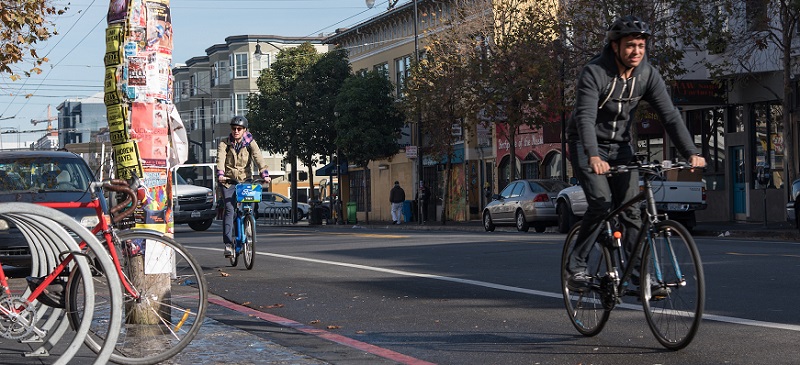
Valencia Street is one of San Francisco's highest utilized bike routes with 2100 cyclists riding along it on an average weekday. With parts of Valencia on the city’s High-Injury Network, we had a series of workshops in July to address safety and improve infrastructure along this corridor.
Since the workshops, the project team received a lot of insightful feedback regarding the bikeway design alternatives and the near-term curb management (i.e., parking and loading) improvements from the community. This blog post provides a glimpse of what’s to come for the project over the next few months.
Bikeway Update: Market to 15th streets
Per the directives and partnership of Mayor London Breed, parking-protected bike lanes will be piloted on Valencia from Market to 15th streets in early 2019. In tandem with the bikeway upgrade, curb management changes will also be implemented on this stretch of the corridor. The project team will be conducting door-to-door outreach with merchants and following-up with stakeholders in the upcoming weeks. At this time, the parking-protected bikeway pilot is anticipated to be heard at the SFMTA Board of Directors meeting on December 4, 2018. Following that, city crews would begin constructing the parking-protected bike lanes, using temporary, low-cost materials as much as possible. Following the implementation, the project team will evaluate the design to help inform the longer-term, corridor-wide project. Additional outreach and community conversations will be held in spring and summer 2019 to determine a preferred bikeway design alternative(s) for the entire corridor.
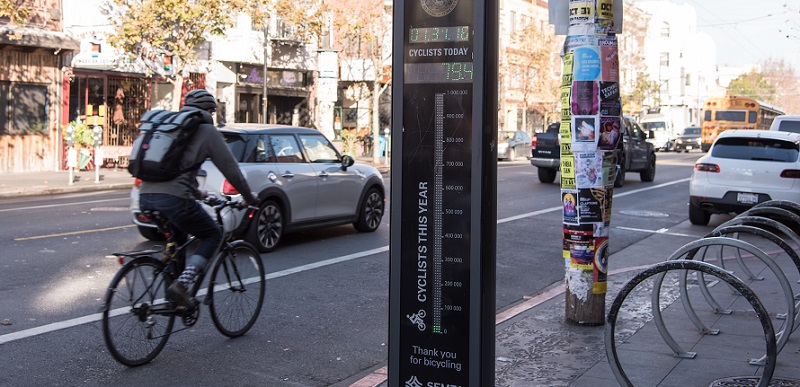
Curb Management Update: 15th to 24th streets
In the upcoming weeks, the project team will also be conducting another round of merchant door-to-door outreach to get feedback on impacts of potential color curb changes on Valencia Street from 15th to 24th streets. Most curb management improvements in this portion of Valencia include consolidating loading (passenger and commercial) zones and implementing more passenger loading zones that will be in effect past 6 p.m. The project team plans to share these proposals with the community later this fall. Please be on the lookout for another update in a few weeks detailing the next community event.
Thanks for your interest and involvement in the Valencia Bikeway Improvements project. To stay in the loop about the project and upcoming events, please sign up for project updates.
SFMTA is proud to sponsor the 16th anniversary of the San Francisco Trolley Dances. And our Muni train cars will get you a front seat for the performances!
This two-day, free (with Muni fare) public performance curated by Epiphany Dance Theater artistic director Kim Epifano. This year’s route travels along the J-Church Muni line, from Mid-Market/Tenderloin to Noe Valley. Participating artists include Lily Cai Chinese Dance Company, Micaya's Soulforce Dance Company, Gerald Casel, Guillermo Galindo, Gregory Dawson's dawsondancesf, Evie Ladin's MoTor/dance, Juliano Wade, and Kim Epifano's Epiphany Dance Theater.
Welcome Registration Booth + Tour Starting Point:
International Art Museum of America, 1023 Market St.
Trolley Dances times are:
11 a.m., 11:45 a.m., 12:30 p.m., 1:15 p.m., 2 p.m., 2:45 p.m.
Each tour runs approximately two hours
Make your plans to go and get tips on how to get the most of the SF Trolley Dance fun at www.epiphanydance.org.
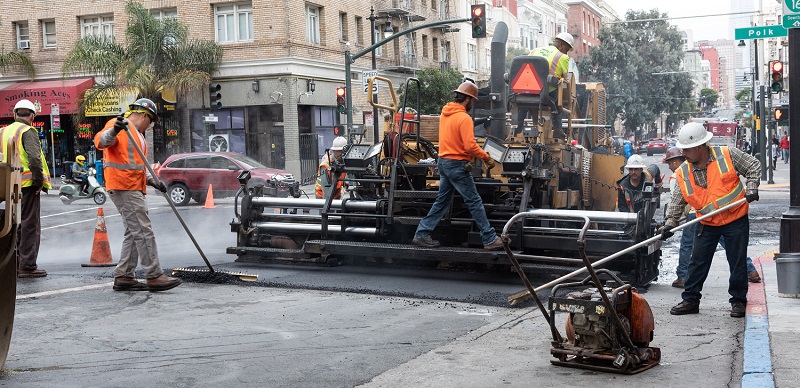
The Polk Streetscape Project is near completion! As we work with San Francisco Public Works to finalize everything, here’s what you need to know about the new bike lanes, streetscape amenities, parking and loading as crews put the finishing touches on this two-year construction project.
What’s Next?
Polk Street, north of Jackson Street has been paved and striped. Over the next month, crews will be paving Polk Street from Bush to McAllister streets, with final roadway striping happening in November and December. Parking and loading changes will occur with the new striping, including the removal of all parking on the east side of Polk Street between Pine and McAllister streets and some removal of general metered parking on the west side of Polk Street with improved commercial and passenger loading spaces to better accommodate the area’s demand.
Since August 2012, the SFMTA worked with the community on a two-year comprehensive outreach process to better understand needs and concerns from residents, merchants and community groups. This outreach included:
The final project combines the ideas from the community with a clear understanding of where and why collisions are happening on Polk and the improvements needed to prevent them. This project was approved by the SFMTA Board of Directors in March 2015 and project construction began in fall 2016.
This project will also unveil a new bikeway design for the corridor. At the intersections of Geary, Ellis, Eddy and Turk, in the southbound direction, the bike lane will be signal separated from southbound vehicles right turns to improve safety for users. On the west side, parking and loading changes are being implemented to meet the specific needs of the neighboring businesses as determined in the SFMTA’s extensive outreach process. Parking on the east side will be removed between McAllister and Pine streets to accommodate a new bike lane adjacent to the curb and separated from traffic.
The project also includes a suite of pedestrian and transit improvements including bulb-outs and pedestrian lighting as well as new sidewalk trees. With the project, Fern and Austin alleys will also be receiving upgrades, with pedestrian enhancements including raised crosswalks, improved lighting and trees, and space for residents, shoppers and people passing by to enjoy.
The final illustrative plan for Polk Street is available here. The project is anticipated to be completed in December 2018. For updates, visit the San Francisco Public Works webpage.
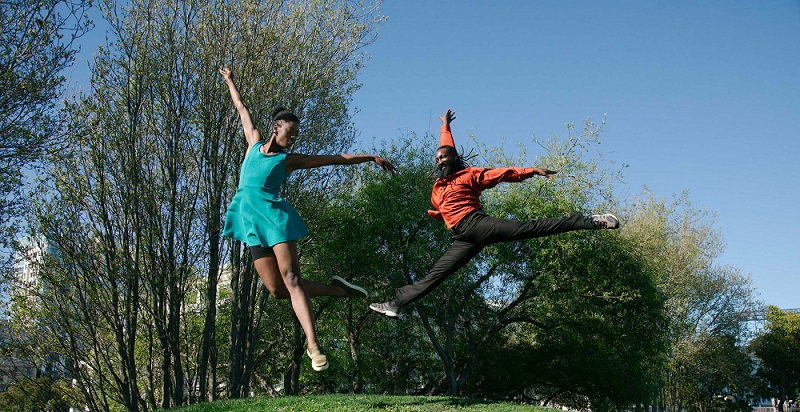
Photo courtesy of Epiphany Dance photographer Andy Mogg.
Saturday - Sunday 11 a.m. - 4 p.m.
4th & Channel Streets at Mission Creek Park
San Francisco Trolley Dances, now in its 15th anniversary season, is a two-day, free (with Muni fare) public performance curated by the Epiphany Dance Theater. Artists and dance ensembles are paired with specific sites along San Francisco’s Muni route, where they are invited to create an 8- to 15-minute dance piece in response to the physical environment, architecture and history of the area. This year’s route takes you from Mission Bay to SoMa. This admission-free festival has been dubbed “Art for citizens” and “A gift to the City” by past attendees, and a record of 5,000 people have joined us for a weekend of art and community. Line up for wristbands begins at 10 am. Show up early as they often have given out all of the wristbands hours in advance. Wristbands are given out on a first come, first serve basis.
How to Get There on Muni: Riders may take N Judah or the KT Ingleside.
Muni Service Notes: There are no planned service changes for this event, however, routes in the area may see minor delays or increased ridership near Mission Bay.
Saturday, 11 a.m. to 4 p.m.
Potrero Hill
The Potrero Hill neighborhood will be hosting its 28th annual eponymous festival this Saturday on 20th Street between Missouri and Wisconsin streets. The Potrero Hill Festival celebrates the community with live music, food, drink and wares from local vendors, local historians, games and much more. There is something for the whole family to enjoy this weekend, so don't miss the opportunity to check out this iconic part of San Francisco.
How to Get There on Muni: Riders may take the 10 Townsend, 19 Polk or 22 Fillmore to near the event.
Muni Service Notes: The 10 will have a reroute for this event. The 19 and 22 may see minor delays or increased ridership in the area of the event.
Saturday, 11 a.m. to 5 p.m.
Fisherman's Wharf
Returning to Fisherman's Wharf for the sixth consecutive year, Wharf Fest showcases the historic wharf after the crowds of visitors have dissipated with a street fair atmosphere featuring over 50 booths of vendors, free activities, food and drink. The highlight of the event is surely the Clam Chowder Competition and Tastings, as Fisherman's Wharf restaurants battle it out to see whose clam chowder reigns supreme. Wharf Fest is a free event open to the public, however, tickets are required for the Clam Chowder Competition.
How to Get There on Muni: Riders may take the E Embarcadero or F Market and Wharves streetcar lines, as well as the 8 Bayshore, 19 Polk, 28 19th Avenue, 30 Stockton, 39 Coit, 47 Van Ness or the 49 Van Ness/Mission routes to near the event.
Muni Service Notes: There are no planned service changes for this event, however, routes in the area may see minor delays or increased ridership near the Wharf.
Remember that you can Muni the entire day for a single $5 fare. The new $5 Day Pass, available on MuniMobile®, is part of Muni’s recent fare changes. The pass is intended to encourage a safe, convenient way to pay your fare and quickly board Muni vehicles, which reduces overall travel time for everyone. The $5 Day Pass is Muni bus, rail and historic streetcars only.
“On Tap” gives you a heads up about the big events in town and what Muni routes and lines will get you to the party. Look for this feature to be posted usually on Thursdays for a look ahead to the weekend. Check out our Weekend Traffic & Transit Advisory for more details.
Vietnamese Title VI discrimination complaints Sở Giao thông Đô thị San Francisco (SFMTA) cam kết điều hành những chương trình và dịch vụ của sở với tinh thần không phân biệt chủng tộc, mầu da và nguồn...
Khi thành phố phục hồi sau đại dịch COVID-19, SFMTA đang phát triển một đề xuất về cách thức dịch vụ Muni sẽ được khôi phục vào đầu năm 2022. Tham gia nhóm dịch vụ Muni cho sự kiện open house (dịp...
Dịch vụ Muni sẽ như thế nào vào năm 2022? Kể từ tháng 4 năm 2020, SFMTA đã phục hồi dịch vụ Muni đã có sẵn trước đại dịch COVID-19, bổ sung thêm dịch vụ ở các lộ trình đông người, tạo các tuyến đường...
Khi thành phố phục hồi sau đại dịch COVID-19, SFMTA đang phát triển một đề xuất về cách thức dịch vụ Muni sẽ được khôi phục vào đầu năm 2022. Tham gia nhóm dịch vụ Muni cho sự kiện open house (dịp...
Khi thành phố phục hồi sau đại dịch COVID-19, SFMTA đang phát triển một đề xuất về cách thức dịch vụ Muni sẽ được khôi phục vào đầu năm 2022. Hình thức của giờ làm việc là mở cửa cho người tham dự đặt...
Better Market Street is an ongoing, collaborative effort to redesign San Francisco’s most important street. Market Street can become a place where people can gather, spend time and enjoy the sights of the city, as well as a convenient way to access transit, connect by bicycle and walk to diverse destinations along the corridor.
As part of Muni Forward, SFMTA has identified the 5 Fulton corridor as being a part of its proposed Rapid Network. In most cities, a Rapid Network is bus service with dedicated lanes and vehicles that allows transit to move swiftly on the street. With our Rapid Network, we intend to build transit priority lanes with efficient stop spacing to move buses quickly along their routes. We’ll also create better boarding zones to make it safer and faster for passengers to get on board, and make it easier to find our bus stops and shelters with improved signage.
The 5 Fulton route carries about 19,000 daily customers on an average weekday. The route’s study corridor is 5.6 miles long and includes Fulton Street between La Playa and Central Avenue, Central Avenue between Fulton and McAllister streets, and McAllister Street between Central Avenue and Market Street. Within the study area, the 5 Fulton operates at an average speed of 9.7 miles per hour during peak periods. In order to reduce transit travel times and improve reliability within its proposed Rapid Network, the SFMTA proposes a toolkit of measures within the study area.
To reduce travel times and enhance reliability on the routes that make up its proposed Rapid Network, Muni Forward has identified a variety of Travel Time Reduction Proposals (TTRPs), which are engineering strategies oriented to specifically address the delays vehicles face along rapid routes. As a part of the proposed Rapid Network, the 5 Fulton has its own toolkit of TTRPs, which specifically target the evaluated causes of delays within the 5 Fulton corridor. The proposal includes:
Vào ngày 21 tháng 2 năm 2022, SFMTA đã hoàn thành thành công cuộc khảo sát công khai ban đầu cho Thung lũng Visitacion và Kế hoạch Vận tải Dựa vào Cộng đồng Portola (CBTP). Hiện chúng tôi đang trong...
Dịch vụ Muni sẽ như thế nào vào năm 2022? Trong những tháng vừa qua, chúng tôi đã chia sẻ ba lựa chọn khác nhau về việc làm thế nào để có thể tăng dịch vụ vào đầu năm 2022. Chúng tôi đã nhận được ý...
Vào mùa thu năm 2021, chúng tôi đã tìm hiểu ý kiến người dân San Francisco rằng chúng tôi nên ưu tiên điều gì khi chúng tôi có thể bổ sung thêm dịch vụ Muni vào đầu năm 2022. Chúng tôi đã nhận được...
Chúng tôi muốn lắng nghe từ quý vị. Cơ Quan Giao Thông Vận Tải Thành Phố San Francisco sẽ tổ chức các cuộc họp cộng đồng để thảo luận về ngân sách hai năm, bao gồm những thay đổi có thể xảy ra về giá...
Tìm hiểu về giá vé, các yêu cầu để ghi danh, và các nơi bán vé tháng và vé lượt giảm giá cho người cao niên người khuyết tật và bệnh nhân có Medicare. CÁC LOẠI GIẤY TỜ CHỨNG MINH ĐƯỢC CHẤP NHẬN Khi sử...
VÉ XE CÁP Quý vị có thể mua vé từ nhân viên bán vé trên xe cáp. Vui lòng chuẩn bị sẵn tiền lẻ. Vé không cho phép di chuyển giữa các xe cáp. Sau khi xuống xe, quý vị phải trả giá vé đầy đủ để lên xe...
Cho dù bạn ở đây trong một ngày hay trong vài tuần, SFMTA sẽ giúp du khách dễ dàng đi lại quanh thành phố một cách dễ dàng. Bạn có thể mua Hộ chiếu Du lịch tại các quầy bán vé, trên Clipper® và các...
Cho dù bạn ở đây trong một ngày hay trong vài tuần, SFMTA sẽ giúp du khách dễ dàng đi lại quanh thành phố một cách dễ dàng. Bạn có thể mua Hộ chiếu Du lịch tại các quầy bán vé, trên Clipper® và các...
Cho dù bạn ở đây trong một ngày hay trong vài tuần, SFMTA sẽ giúp du khách dễ dàng đi lại quanh thành phố một cách dễ dàng. Bạn có thể mua Hộ chiếu Du lịch tại các quầy bán vé, trên Clipper® và các...
Được thành lập theo đề xuất của cử tri vào năm 1999, Cơ quan Vận tải tại Thành phố San Francisco (San Francisco Municipal Transportation Agency, hay SFMTA) quản lý hệ thống giao thông đường bộ của...
The Muni Metro light rail system features six lines: the J Church, K Ingleside, L Taraval, M Ocean View, N Judah and the T Third. These lines serve downtown and neighborhoods in the western and southeastern parts of San Francisco. Below is more detailed information on the accessible features in our Metro system, how to board in the subway, how to board on the surface, and some additional tips for using the Metro.
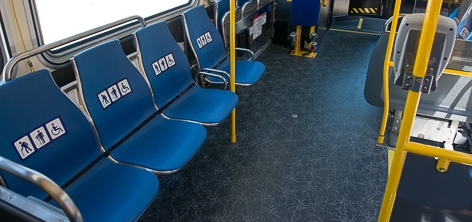
Priority seating for seniors and customers with disabilities is located immediately behind the train Operator’s compartment at both ends of the car. The priority seating includes the first rows of aisle-facing seats, which flip up to accommodate a wheelchair, and the first rows of forward-facing seats.
Please Note:
On crowded trains, the priority seats may already be occupied by seniors and people with disabilities or by other customers. Upon request, operators can ask passengers to give up their seats, but cannot force them to do so.
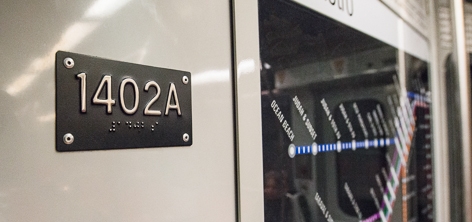
All vehicles have a vehicle identification number plate at each end that includes four digits plus the letter A or B to denote the end of the vehicle. The signs are located approximately 60" from the floor on the flat panel behind the Operator’s compartment and include raised characters and braille. Customers must provide the vehicle number in order to report problems with equipment or service.
Vehicles are equipped with push button-activated intercoms, to be used in case of emergency, which allow customers to communicate with the train Operator. The intercoms are located next to the door behind the Operator’s compartment at each end of the car.
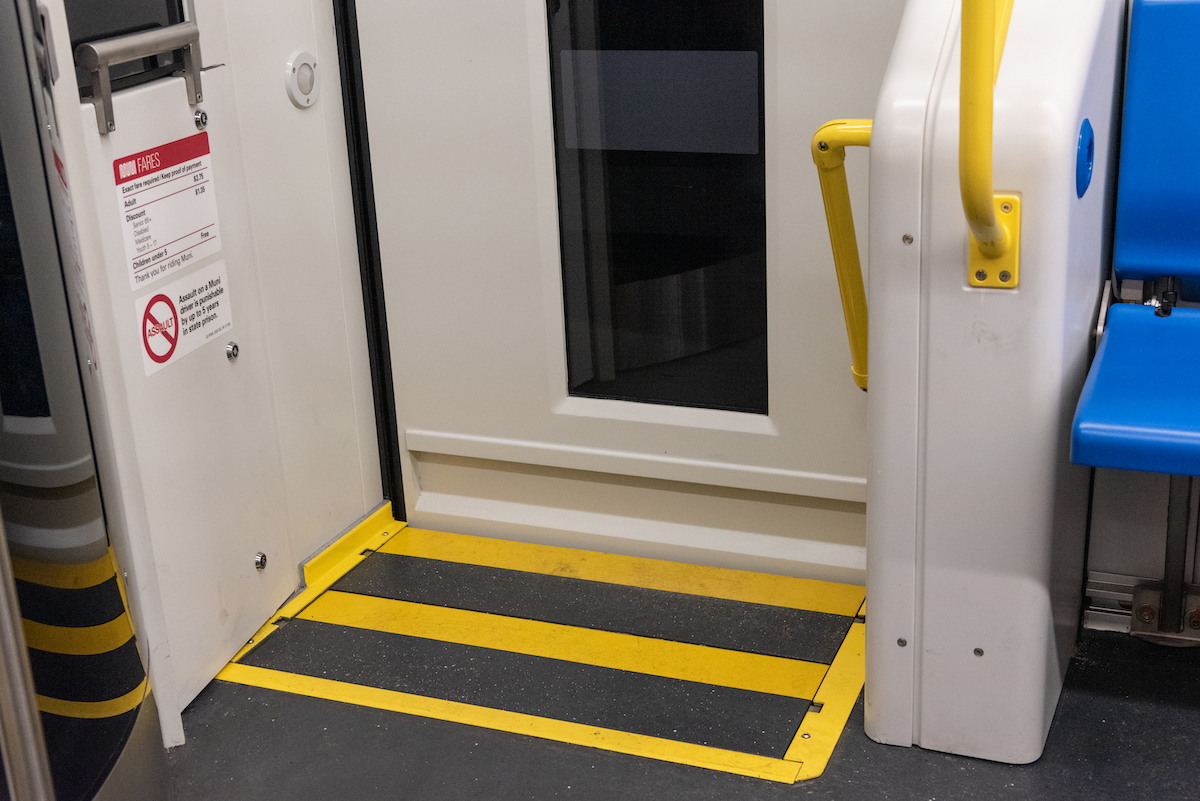

The stairwells on all of our LRVs can be raised or lowered. For street level stops on the surface, these steps are kept in the lowered position. For stops at high level platforms the stairs are raised. A bell sounds when the steps are lowering to warn passengers to move away from the doors. At high level platforms, step extensions, which deploy automatically when the doors are opened, are used to reduce the gap between the LRV floor and the station platform.
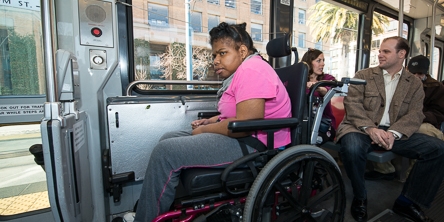
Each LRV is equipped with four flip-up seating areas near the front and rear of the train car. These seats can be flipped up to accommodate most mobility devices. If you are concerned about whether your mobility device can be accommodated, please contact SFMTA Accessible Services (415.701.4485; TTY 415.701.4730).
Segways
Muni may be able to accommodate a Segway, when used as a mobility device. You will need a Permit. For more information on Segway accommodations, please call or contact Matthew West (415) 701-4439, or Matthew.West@SFMTA.com.
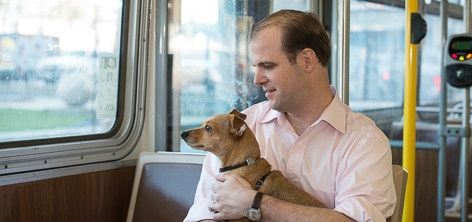
Service Animals are allowed on the Muni Metro. Service animals must be leashed and under the control of thier owner at all times.
More Information:
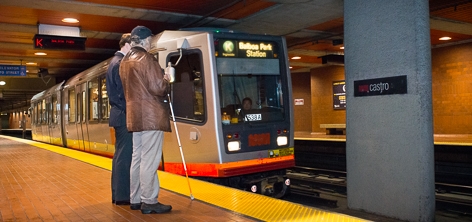
The Muni Metro stations from West Portal to The Embarcadero are underground. The downtown subway stations (between Civic Center and The Embarcadero) are shared by Muni and the Bay Area Rapid Transit District (BART). These stations are multi-level, with a concourse level, a Muni boarding platform at mid-level and a BART platform at the lowest level. Downtown stations are identified by distinctive print signs and braille signs.
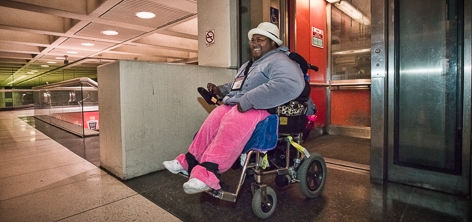
All underground stations are accessible by elevator. The street level elevators at each station are located on the north side of Market Street near a station entrance and are marked by a sign. The street elevator will take you to the concourse level, where signs are posted to direct you to the platform elevator. At the concourse level of the shared downtown stations, Muni and BART have separate and distinct station agent booths and faregate arrays. A shared elevator provides access from the concourse to both the Muni and BART platform levels. For information on elevator status, please call the San Francisco Customer Service Center at 311 (415.701.2311 outside of San Francisco). You may also contact BART’s elevator information line at 510.834.LIFT (510.834.5438) or 888.235.3828. Elevator alerts can be texted to your phone by signing up for "Watch Route Alerts" and choosing to receive alerts for either the J, K, L, M, N or T Lines (text message rates apply).
More Information:
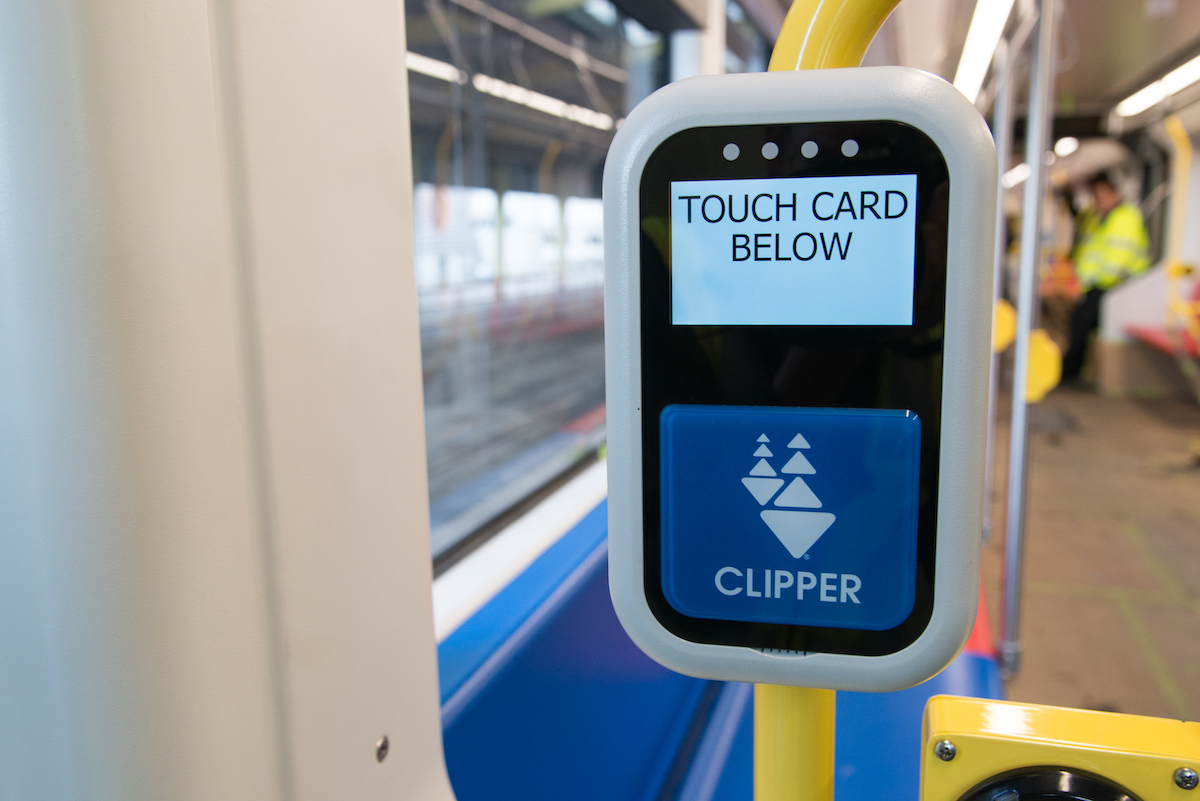
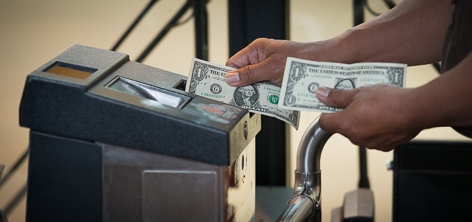
You must pay your fare prior to boarding the elevator to the platform. Passengers are encouraged to pay with a Clipper Card by tagging the card at the Clipper reader near the elevator to the platform. Passengers who are eligible to pay a discounted fare but do not have a Clipper Card or transfer must purchase a ticket from a ticket vending machine near the station agent booth. The ticket must be tagged at the Clipper reader on the concourse level near the elevator in order to serve as valid proof of payment.
More Information:
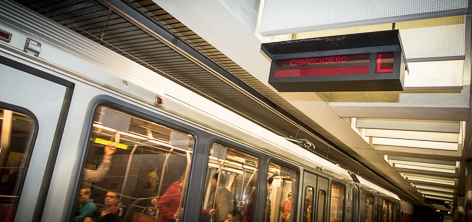
Once on the Muni platform of a shared station, signs will direct you to the inbound or outbound side. Look for the red “boarding area” signs on the trackside walls (opposite the platform waiting area) that indicate where to wait for a train. On the platform, overhead digital signs display the line name and destination of the train that is boarding as well as the next train pulling into the station. A recorded voice also announces the predicted arrival time of the next three trains in the subway. Metro maps are installed on the trackside walls and tactile maps of the entire Muni system are located on the subway platforms at the inbound and outbound boarding areas.
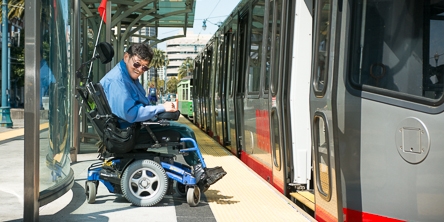
Accessible stops for wheelchairs and other mobility devices are located at regular intervals and at major destinations such as schools and hospitals. Accessible surface stops are generally low-level island stops with a ramp up to a small high-level platform for those who need level boarding.
On the T Line all surface stops are wheelchair accessible, with high platforms that provide level boarding at all doors. There are ramps at one or both ends of these platforms. On the M Line, the platforms at Stonestown and San Francisco State are also high-level platforms.
More Information:
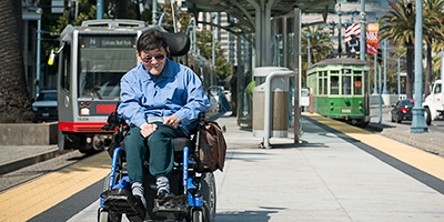
To board from an accessible island stop, wait for your train on the high platform. When the train arrives, the Operator will raise the interior stairs and position the vehicle so that you can board at the first door. Let the Operator know your destination stop as soon as you board and whether you need help with the jump seats at a stationing area. Wheelchair users should then proceed to the wheelchair stationing area, which is created by flipping up one of the first sets of aisle-facing seats next to the door.
Note:
When traveling from downtown to a street level destination on the J, K, L, M or N lines you MUST board the first door of the first car of the train. Be sure to let the Operator know your destination in advance so that they can properly position the train at the accessible platform.
Boarding at San Jose and Geneva Ave.
On the M Line, the accessible stop at San Jose and Geneva avenues has a mechanical wayside lift that elevates customers to the level of the train floor for boarding and exiting. The lift is separated from the boarding island by a gate, and remains in the lowered position when not in use. To use the lift, go through the gate and wait for a train on the lift platform. Locate the control button (on your left when facing the train). When the LRV arrives, push and hold the “up” button to raise the lift. Press the button continuously or the lift will stop. If you are unable to press and hold the button, the train Operator can raise and lower the lift from inside the train. Note that the lift will not operate until the train stops next to the platform.
Note:
When traveling from downtown to a street level destination on the J, K, L, M or N lines you MUST board the first door of the first car of the train. Be sure to let the Operator know your destination in advance so that they can properly position the train at the accessible platform.
Our lifts can lift up to 600 pounds and can accommodate a mobility device measuring no more than 30 inches by 48 inches. If you are concerned about whether your mobility device can be accommodated, please contact SFMTA Accessible Services (415.701.4485; TTY 415.701.4730).
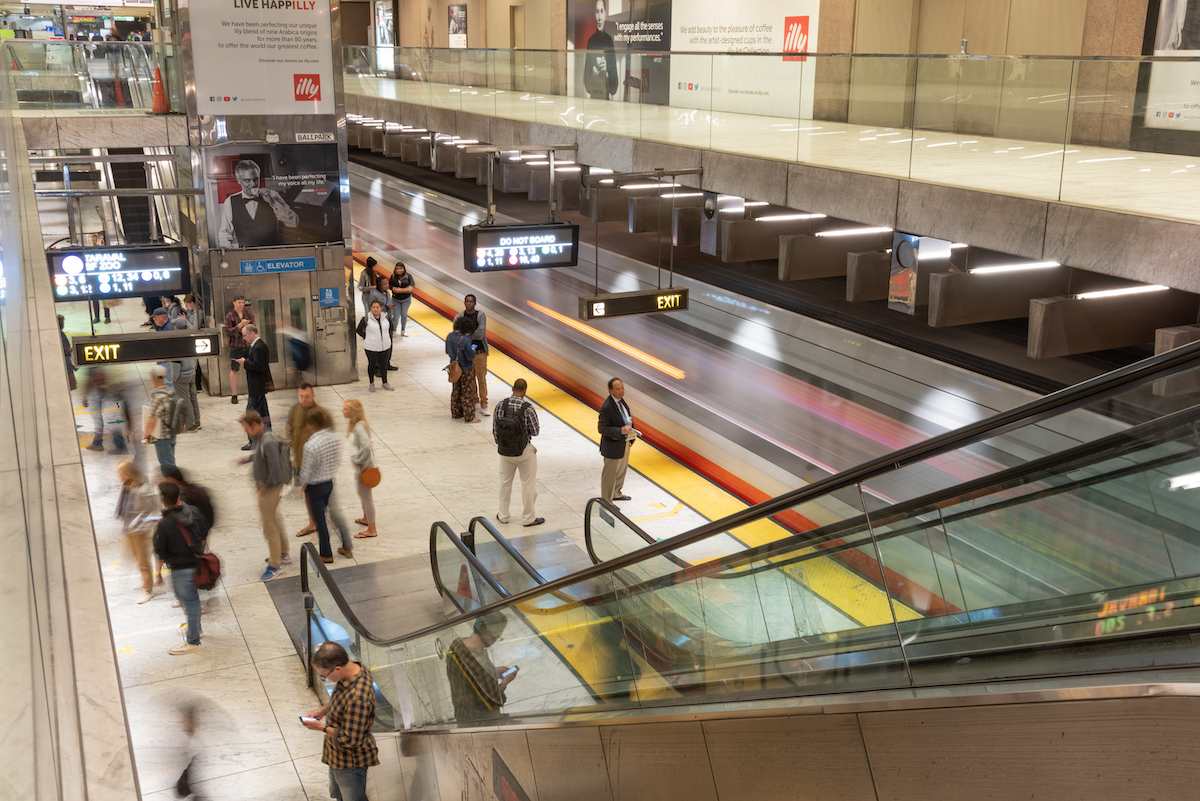
All underground station entrances are easily identified by sidewalk signage. They also have Braille station name signs, often on the right hand side of the stairwell. All subway stations are accessible by elevator, escalator or stairs and comprise of two levels, a concourse and a platform level. An accesisble fare gate is availible for use and is located immediatly adjacent to the station agent booth.
Yellow tactile tile is provided on the platfrom level to indicate the edge of the boarding platform; please stand behind the tactile tile at all times while on the boarding platfrom.
Stations are either center platform (tracks on either side) or side platform (two platforms with tracks in between).
Center Platform Locations
Side Platform Locations
Automated Announcements
In the underground stations (Embarcadero, Montgomery, Powell, Civic Center, Van Ness, Church, Castro, Forest Hill and West Portal), a digital voice announcement system announces the route designation and arrival time of approaching and arriving trains. Announcements of upcoming stations are made inside the train.
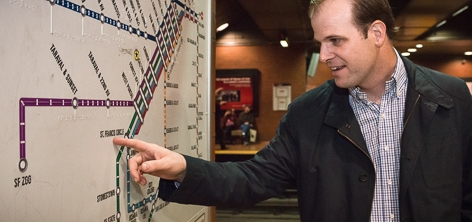
Maps of the Metro system with Braille and raised characters are installed on the concourse and platforms levels of underground stations. Braille and Tactile Maps of certain Muni Metro lines are also available from the San Francisco Lighthouse for the Blind; more information on this program can be found here.
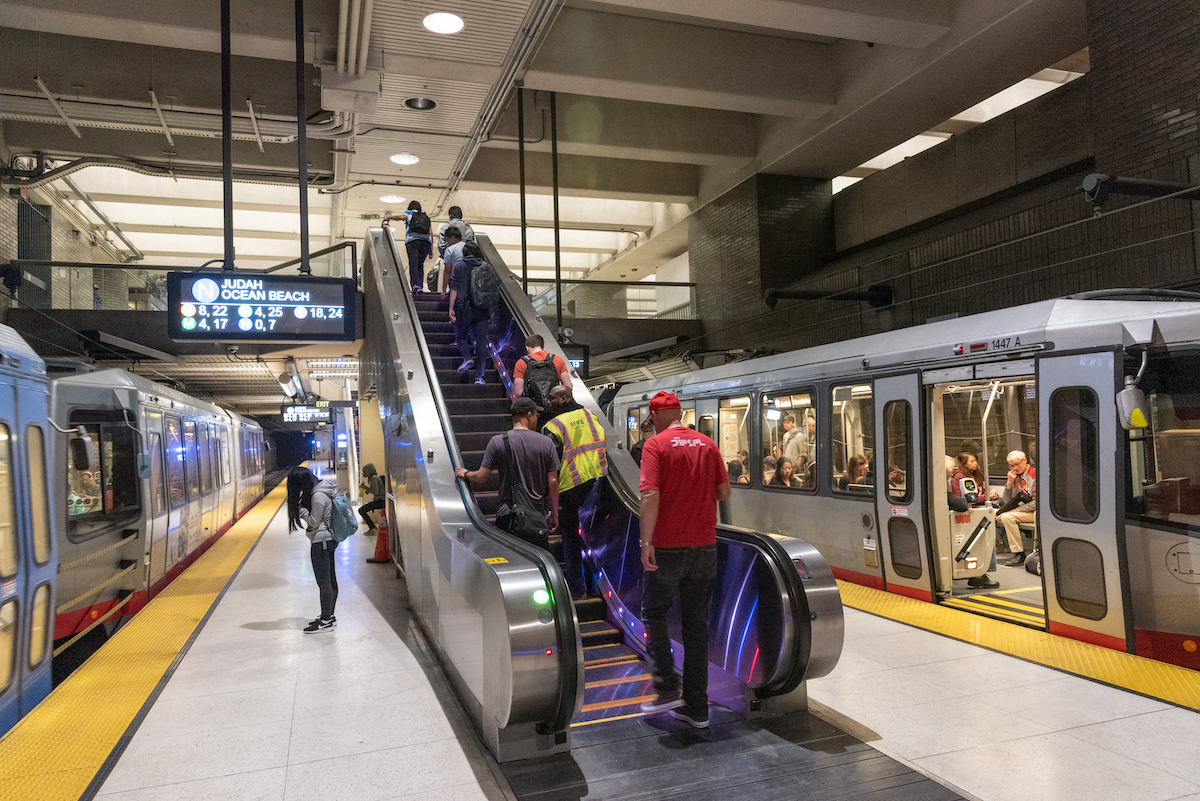
Stair and Escalator Locations
Stairs and/or an escalator are located at each end of every downtown station. Inbound trains stop near the middle of the platform and outbound trains stop at the far end of the outbound platform.

Metro cars are equipped with a chime that sounds in each doorway to help guide people with visual disabilities to the door opening.
Caution:
All light rail vehicles taper or narrow at each end, creating a larger vehicle-to-platform gap. When looking for a doorway, be sure to locate the floor of the train before stepping off the platform. Do not mistake the gap between the end of a car and the platform for the gap between the platform and the train doorway.
Vào mùa thu năm 2021, chúng tôi đã tìm hiểu ý kiến người dân San Francisco rằng chúng tôi nên ưu tiên điều gì khi chúng tôi có thể bổ sung thêm dịch vụ Muni vào đầu năm 2022. Chúng tôi đã nhận được...